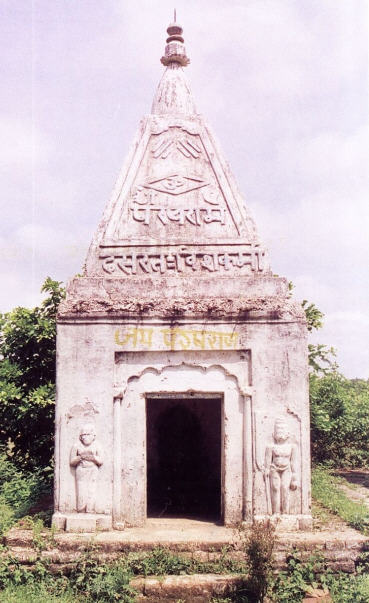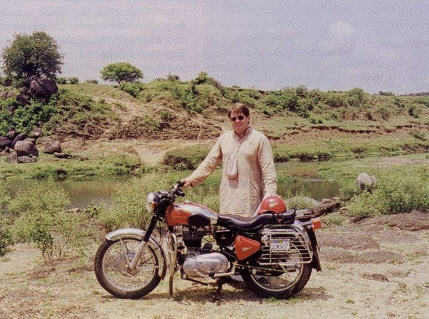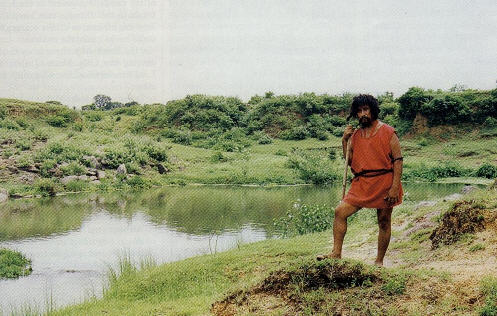A Western pilgrim finds a rare, nearly unknown shrine built in honor
of Lord Krsna's warrior incarnation.
"You are all the descendants of the ksatriyas [warriors] who ran from the ax of Lord Parasurama." The words stunned me. It was 1971, and I was sitting just at the feet of Srila Prabhupada, my spiritual master. He was seated royally upon the holy vyasasana (seat of the guru), lecturing to a large gathering at the Brooklyn ISKCON temple. I paused to muse that somehow Srila Prabhupada had the potency to speak astounding never-before-heard things in such a matter-of-fact way that the listener knew at once that whatever he heard was the truth. And I was excited to be hearing, learning, and realizing Krsna consciousness all at once. Sitting at the lotus feet of His Divine Grace, I could see that his abilities came not only through his inner realization of the highest order, but from a power descending via disciplic succession, like electricity through a wire.
Across Europe and Asia
Srila Prabhupada continued to explain how Lord Parasu-rama, an incarnation of the Supreme Lord Sri Krsna, had single-handedly defeated vast armies of errant warriors,  emerging victorious after each encounter. Many of the ksatriyas had escaped and traveled west across Asia, eventually settling in parts of Europe. Later I would realize that this provides one explanation for the Sanskrit influence upon languages of every European tongue Germanic or Romantic and upon the names of European countries and regions.
emerging victorious after each encounter. Many of the ksatriyas had escaped and traveled west across Asia, eventually settling in parts of Europe. Later I would realize that this provides one explanation for the Sanskrit influence upon languages of every European tongue Germanic or Romantic and upon the names of European countries and regions.
In only a few thrilling sentences, Srila Prabhupada had linked all of us Westerners to his Vedic culture and civilization. Rebels of the sixties, we were now handed an identity we could be proud of.
Within a few years I found myself drawn to India. I was traveling by bus and train across Europe and western Asia, in a reversal of the migration of my past "ancestors." I was moving slowly, keeping Srila Prabhupada's words in my mind and looking in France, Italy, Turkey, Iran, and Afghanistan for vestiges of Vedic culture, which resettling ksatriyas might have brought with them ages earlier. It would be no exaggeration to say that I saw hundreds of such reminders along the way.
In India I learned that temples and holy places connected with the worship of Lord Parasurama are rare. At the Himalayan town of Uttar Kashi, the "northern Benares," I came across a very small Sri Parasurama Mandir just above the famous temple of Ekadasa Rudra, "the eleven forms of Siva." A sadhu passing by explained to me that because Lord Parasurama had once performed penance at this spot, a tiny shrine had been built here many hundreds of years ago in his honor. He added that he knew of no other Sri Parasurama shrines except one, a Parasurama Kunda (lake) in Assam. (Unfortunately, a few years later the Brahmaputra River flooded the area, and in the late 1970's the shrine in Assam was lost.)
Sitting before the deity of Lord Parasurama and chanting Hare Krsna on my beads, snow-capped Himalayan peaks high above me and the roaring Ganga just below, I felt a strong reverence for this incarnation of Krsna. After all, any demon killed by the Supreme Lord is granted moksa, or liberation. Since my physical lineage is European and therefore from ksatriya roots, I could have had ancestors liberated by the Lord's ax millions of years earlier.
I had to wait only a few months longer to discover the full version of Lord Parasurama's pastimes (lila) in the Srimad-Bhagavatam. By then I would be at the developing Hare Krishna Land in Mumbai, trying to serve Srila Prabhupada in some small capacity. Prabhupada's Ninth Canto of Srimad-Bhagavatam had just arrived, and therein, in Chapters Fifteen and Sixteen, I was to learn more about Lord Parasurama's pastimes.
Discovery of Parasurama Kunda
Now fast forward with me from the time I first learned of the details surrounding Lord Parasurama's lila to 1980. It was the time of my marriage to Raagini, a young Hindu lady, a medical graduate from Jabalpur, in Madhya Pradesh. After an elaborate wedding in Lucknow and "honeymoon," or, rather, pilgrimage, to the Himalayas, my bride and I traveled to stay with her family at Jabalpur, a large city nestled between the Vindhya Hills and the Narmada River. There I made friends with a few local panditas, and by day I would scooter about in my discovery of local holy places.

I visited the place where Hanuman and his friends played before they joined the army of Lord Rama to defeat Ravana. I saw high above the Narmada in white marble cliffs the cave where Lord Dattatreya, a combined incarnation of Brahma, Visnu, and Siva, had meditated. I boated up the sparkling emerald Narmada to a place of the penance of Banasura, whose daughter married Lord Krsna's grandson, Aniruddha. Banasura was the descendant of Prahlada Maharaja and son of Bali Maharaja. At Banasura Ghat, present-day Bhera Ghat, he worshiped millions of Siva-lingas. Hence it is from this place that the Narmada produces self-manifested (svayambhu) Siva-lingas that are worshiped in temples all over India. Since Banasura's daughter Usa married Krsna's grandson Aniruddha, son of Pradyumna, Banasura became a member of Krsna's family after a great war described in the Srimad-Bhagavatam.
I walked for days in the Vindhya Hills, once a towering mountain range whose great height had "the power to block the sun." These mountains became hills when they bowed to the sage Atri, who had intervened on behalf of the sun-god. But the mountains left behind huge boulders betraying their once monumental past. Indeed, Jabalpur and the extended surrounding area is a charming and undiscovered part of the world containing holy spots where devatas (demigods) once played. Today gentle village folk till fertile fields, and primitive tribals dwell in jungles along with tigers, deer, and wild bison.
One day while searching the area, I asked my guides if they knew of any nearby place of penance, or tapo-bhumi, of Lord Parasurama. I knew that he had sheltered himself in the Vindhya Hills, and perhaps a place of his penance could be found.
One of my local guides, Sri Gyan Prakash Khare, told me of a Parasurama Kunda along the Pariat River, a Narmada tributary. Beside it was a lone hill called Parasurama Giri, part of the Vindhyas. The place was in a remote area, part jungle and part farmland, and few locals knew of it.
The next day we hopped on our Vespa scooters and were off exploring. Beyond the bazaars, through the tiniest villages of mud and straw huts, we made our own way into the fields and pathless jungle till we stood overlooking the kunda formed by giant tantaniya stones, so named for the sound caused when the wind blows through them. A quarter mile beyond the kunda was the hill of Sri Parasurama, which (a yogi would later tell me) has a stone at its top marked by the lotus footprints of Sri Parasurama.
"This sila [stone] has been seen by very few men," he said, almost admonishingly, daring me to find it.

Between the hill of Parasurama and his kunda is a usually deserted Sri Parasurama Mandir, erected a few generations ago by local village folk. Within the tiny temple's sanctum is a rare smiling deity of Lord Parasurama holding his parasu (ax) in much the same way as he does at his Uttar Kashi temple. As it is said, the Lord is very enchanting and inviting to the devotees, yet fearful to the demons.
A festival is held here each year on Makara Sankranti (in January), when Lord Surya Narayana, the sun-god, enters Capricorn (by Vedic calculations), and thus starts his six-month trek through the celestial regions. This is the only festival held here, and it attracts but a handful of villagers. The nearest village, Matamar, is about a mile away and consists of a few mud-and-straw huts. In the surrounding jungle dwell tribal Gonds, who live either by fishing and hunting or by menial jobs paying a day-to-day wage. Whenever I bathe here, several tribals will squat motionless behind the bushes to silently watch. They have their own religion, language, and customs that separates them from mainstream Hindus. Indeed, language and customs vary from tribe to tribe.
An English-speaking yogi moved into the area a few years ago. Nepali-born police officer M. K. Rana has now become renunciant Mahankal Baba. He lives in a hut and eats only things grown by his own hand on the banks of the kunda. He points to the huge trucks in the distance now intruding into the otherwise idyllic setting to make bricks out of the red soil.
"If I don't stop them from desecrating the holy bhumi [land] of Lord Parasurama, then who will?" he asks.
I once asked Baba Mahankal if any other foreigner had visited the kunda in recent memory.
"Are you kidding?" he chuckled. "Even locals don't know of this place!"
While taking pictures for this article, I once asked him to sit on a boulder beside the kunda.
"Why should I sit there?" he demanded indignantly. "I have my own place to sit!"
Another yogi lives in the area, in a small cave beside Parasurama Giri. Because he lost a leg in an accident, villagers bring him a little rice each day. Around his cave, lying abandoned, are archeological treasures: carved pillars of an ornate temple that once stood nearby many centuries ago. In the 1500's, the army of Akbar, Emperor of Delhi, invaded the area. The local queen of Gondwana, Maharani Durgavati, then in her early twenties, raised an army of Gond tribals and fiercely met the invading ranks astride her elephant. Unfortunately she was unfairly killed in the battle. Successive waves of invaders razed many temples, just as Aurangzeb, grandson of Akbar, desecrated the Sri Radha-Govinda Mandir in Vrndavana. The pillars prove that a grand temple once stood here, but research is needed to find out the details. Queen Durgavati's samadhi tomb still stands about twenty-five miles away. Much revered by locals, it is behind the Gaur River, at the spot where she gave her life to protect Vedic civilization.
An Appeal
There is no proper pilgrimage site or temple anywhere in the world dedicated to Lord Parasurama. If this area around Sri Parasurama Kunda were to be reestablished as a shrine, millions of people could learn about and worship this wonderful incarnation of the Supreme Lord Sri Krsna. A motorable dirt trail into the area runs from Panagar on National Highway 7, the Jabalpur-Sihora Road. Thousands of pilgrims travel National Highway 7 each month to visit the Hill of Devi, Goddess Sharada of Maihar. Each pilgrim bus or van would surely stop to see the temples of Sri Parasurama.
The lost jungle shrine of Sri Krsna's avatar Lord Parasurama could be turned into a place of pilgrimage once again, before industries, shopping centers, and horrendous megalithic apartment complexes encroach upon a spiritual treasure. Which will arrive first, bulldozers or devotees?
Patita Pavana Dasa was initiated by Srila Prabhupada in 1968. He has written three books on Krsna conscious astrology (available from Sagar Publications in India) and a guidebook to Vrndavana (available, as is Shri Pushpanjali, from The Hare Krsna Bazaar http://www.krishna.com)
